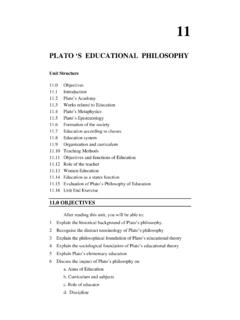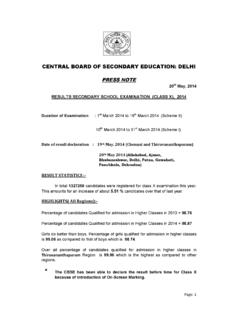Transcription of TOOLS OF RESEARCH - Mu
1 9 TOOLS OF RESEARCH Unit Structure : Objectives Introduction Rating scale Attitude scale Opinionnaire Questionnaire Checklist Semantic Differentiate scale Psychological Test Inventory Observation Interview Let us sum up OBJECTIVES : After reading this unit you will be able to : State different types of TOOLS and techniques used for data collection Distinguish the basic difference between TOOLS and techniques. Describe concept, purpose and uses of various TOOLS and techniques in RESEARCH . State the TOOLS coming under enquiry form, psychological test observation and Interview.
2 INTRODUCTION : In the last chapter, you have studied about how to prepare a RESEARCH tool . In this chapter we will study what are those RESEARCH TOOLS , their concepts and uses in collection of data. 169 In every RESEARCH work, if is essential to collect factual material or data unknown or untapped so far. They can be obtained from many sources, direct or indirect. It is necessary to adopt a systematic procedure to collect essential data. Relevant data, adequate in quantity and quality should be collected. They should be sufficient, reliable and valid. For checking new, unknown data required for the study of any problem you may use various devices, instruments, apparatus and appliances.
3 For each and every type of RESEARCH we need certain instruments to gather new facts or to explore new fields. The instruments thus employed as means for collecting data are called TOOLS . The selection of suitable instruments or TOOLS is of vital importance for successful RESEARCH . Different TOOLS are suitable for collecting various kinds of information for various purposes. The RESEARCH worker may use one or more of the TOOLS in combination for his purpose. RESEARCH students should therefore familiarise themselves with the varities of TOOLS with their nature, merits and limitations. They should also know how to construct and use them effectively. The systematic way and procedure by which a complex or scientific task is accomplished is known as the technique.
4 Techniques is the practical method, skill or art applied to a particulate task. So, as a researcher we should aware of both the TOOLS and techniques of RESEARCH . The major TOOLS of RESEARCH in education can be classified broadly into the following categories. A. Inquiry forms Questionnaire Checklist Score-card Schedule Rating Scale Opinionnaire Attitude Scale B. Observation C. Interview D. Sociometry 170E. Psychological Tests Achievement Test aptitude Test Intelligence Test Interest inventory Personality measures etc. In this unit we will discuss some of the TOOLS of each categories. RATING SCALE : Rating scale is one of the enquiry form.
5 Form is a term applied to expression or judgment regarding some situation, object or character. Opinions are usually expressed on a scale of values. Rating techniques are devices by which such judgments may be quantified. Rating scale is a very useful device in assessing quality, specially when quality is difficult to measure objectively. For Example, How good was the performance? is a question which can hardly be answered objectively. Rating scales record judgment or opinions and indicates the degree or amount of different degrees of quality which are arranged along a line is the scale. For example: How good was the performance? Excellent Very good Good Average Below average Poor Very poor ___|_____|_____|_____|_____|_____|_____| ____ This is the must commonly used instrument for making appraisals.
6 It has a large variety of forms and uses. Typically, they direct attention to a number of aspects or traits of the thing to be rated and provide a scale for assigning values to each of the aspects selected. They try to measure the nature or degree of certain aspects or characteristics of a person or phenomenon through the use of a series of numbers, qualitative terms or verbal descriptions. Ratings can be obtained through one of three major approaches: Paired comparison Ranking and Rating scales 171 The first attempt at rating personality characteristics was the man to man technique devised curing World-war-I. This technique calls for a panel of raters to rate every individual in comparison to a standard person.
7 This is known as the paired comparison approach. In the ranking approach every single individual in a group is compared with every other individual and to arrange the judgment in the form of a scale. In the rating scale approach which is the more common and practical method rating is based on the rating scales, a procedure which consists of assigning to each trait being rated a scale value giving a valid estimate of its status and then comparing the separate ratings into an over all score. Purpose of Rating Scale: Rating scales have been successfully utilized for measuring the following: Teacher Performance/Effectiveness Personality, anxiety, stress, emotional intelligence etc. School appraisal including appraisal of courses, practices and programmes.
8 Useful hints on Construction of Rating Scale: A rating scale includes three factors like: i) The subjects or the phenomena to be rated. ii) The continuum along which they will be rated and iii) The judges who will do the rating. All taken three factors should be carefully taken care by you when you construct the rating scale. 1) The subjects or phenomena to be rated are usually a limited number of aspects of a thing or of a traits of a person. Only the most significant aspects for the purpose of the study should be chosen. The usual may to get judgement is on five to seven point scales as we have already discussed. 2) The rating scale is always composed of two parts: i) An instruction which names the subject and defines the continuum and ii) A scale which defines the points to be used in rating.
9 1723) Any one can serve as a rater where non-technical opinions, likes and dislikes and matters of easy observation are to be rated. But only well informed and experienced persons should be selected for rating where technical competence is required. Therefore, you should select experts in the field as rater or a person who form a sample of the population in which the scale will subsequently be applied. Pooled judgements increase the reliability of any rating scale. So employ several judges, depending on the rating situation to obtain desirable reliability. Use of Rating Scale : Rating scales are used for testing the validity of many objective instruments like paper pencil inventories of personality.
10 They are also advantages in the following fields like : Helpful in writing reports to parents Helpful in filling out admission blanks for colleges Helpful in finding out student needs Making recommendations to employers. Supplementing other sources of understanding about the child Stimulating effect upon the individuals who are rated. Limitations of Rating Scale : The rating scales suffer from many errors and limitations like the following: As you know that the raters would not like to run down their own people by giving them low ratings. So in that case they give high ratings to almost all cases. Sometimes also the raters are included to be unduly generous in rating aspects which they had to opportunity to observe.

